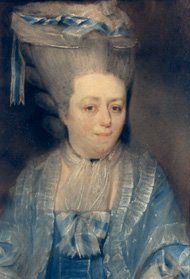
Josina Anna Petronella was born in the Hague in 1733 to the family van Aerssens, an old aristocratic family originally from Belgium. She soon became a lady-in-waiting to Princess Anna and eventually to Princess Anna’s daughter, Princess Caroline. Princess Anna, who came from England, was well-educated in music, having studied with Handel before she arrived in the Netherlands. In court, Josina was surrounded by music. She had the opportunity to hear the famous musicians of the day, including a young Mozart and later Beethoven. In addition, the Princess and her daughter hosted intimate chamber performances where it’s likely Josina participated as a singer, which explains why her works for soprano are so fiendishly difficult.
Interestingly, Josina did not marry until she was thirty-five. When she married Carl van Boetzelaer in 1768, a military man from another old aristocratic family, she was able to remain financially independent due to new inheritance laws. The couple had three children together, although only two survived into adulthood. It wasn’t until after she got married that Josina began to study composing. The records aren’t clear, but she likely started learning with Francesco Pasquale Ricci after the birth of her youngest daughter in 1775. Through him, she discovered the music of Maria Teresa Agnesi and Marianna Martines, contemporaries of hers from Milan and Vienna, respectively.
Ricci left the Netherlands in 1780 after dedicating a set of six ariettas to Josina. After his departure, Josina began to publish her works. In 1795, there was political upheaval in the Netherlands, and the family fled to IJsselstein, where Josina died at the age of 64 in 1797.
Unlike other Dutch women composers, Josina published her works, which preserved them. She published four opuses, several of which are for orchestra and voice. Unfortunately Op. 3 has been lost to time, but 1, 2, and 4 can be found in libraries in Bologna, Zurich, and Slovenia. She was also one of the few native Dutch composers of her time since the court attracted many talented foreign composers.
She set many of her arias to Metastasio libretti, which sets them apart as opera seria was not widely written in the Netherlands. She composed for relatively large-scale orchestras (for the time, at least), so it seems she was not restricted by later ideals of “women’s music,” which shackled Clara Schumann and her contemporaries to writing smaller-scale works. Although it appears that she did not organize performances of her pieces (unlike other aristocratic composers of the time – including Anna Amalia of Prussia), she received acknowledgment from critics of her own time.
Che non mi disse un di
I’ve chosen the aria Che non mi disse un di from her Op. 4 to showcase. She chose a libretto from Metastasio‘s L’Olimpiade and dedicated this whole opus to the famous librettist. This aria is not only incredibly beautiful but highly virtuosic. The anger with which the singer describes her lover’s betrayal contrasts with her deep sadness at losing him again. I performed this aria as part of our livestream mini-concert on June 20. I hope you enjoy the performance, and if you’re interested in learning the piece, you can find music at Hildegard Publishing.
It was difficult to find much information about Josina. This article owes a lot of thanks to “Women Composers: Music through the Ages” and Oxford Music Online. For more information about the composer, check out Helen Metzlaar’s biography “An Unknown 18th-Century Dutch Woman Composer: Josina Boetzelaer (1733-1797)”.